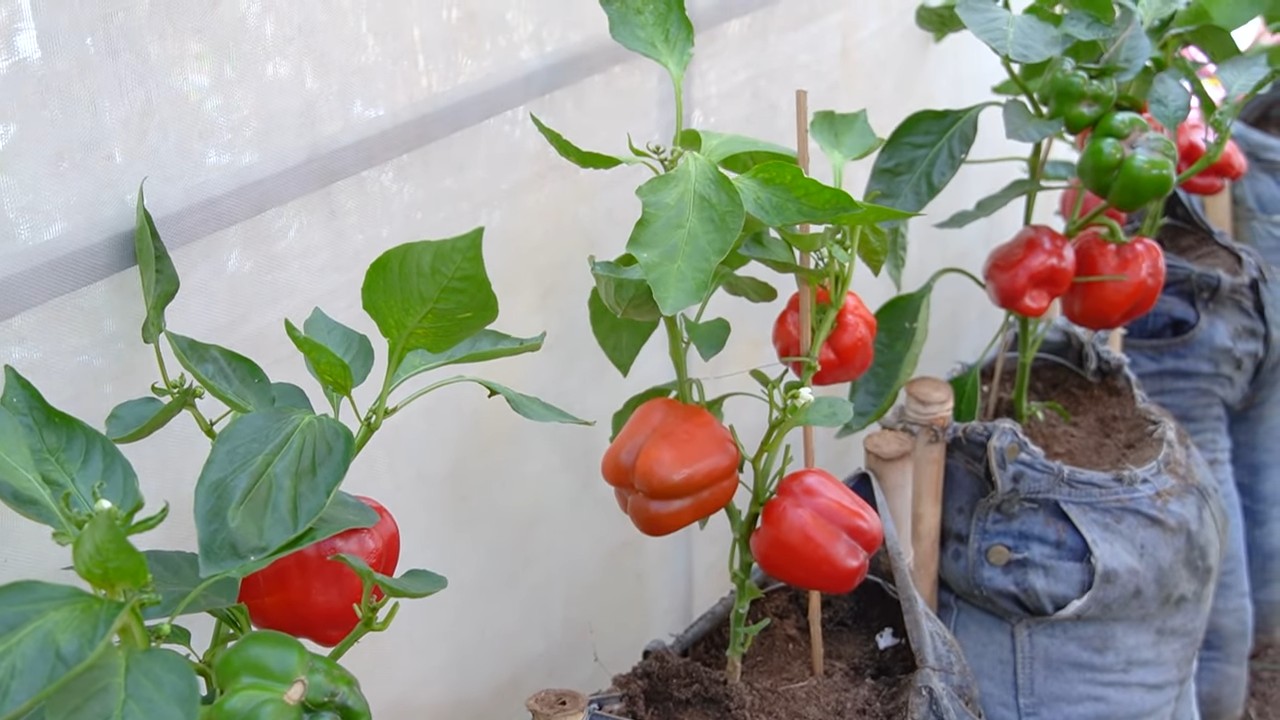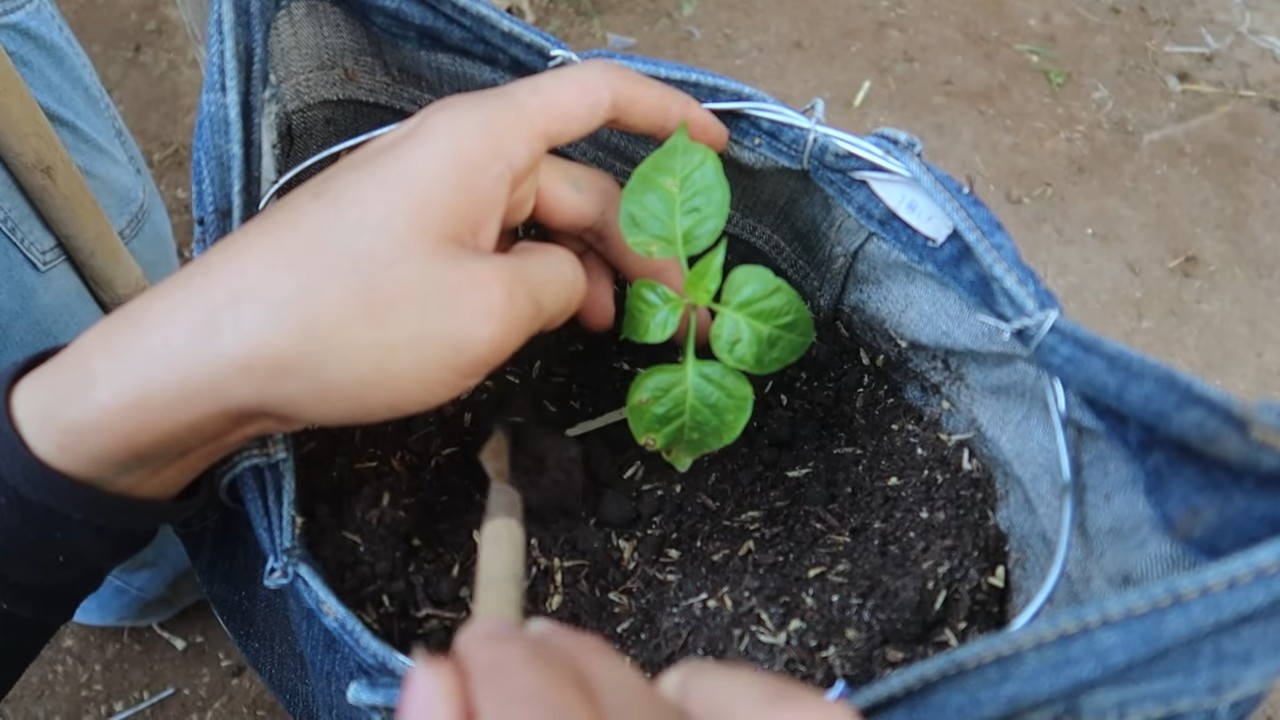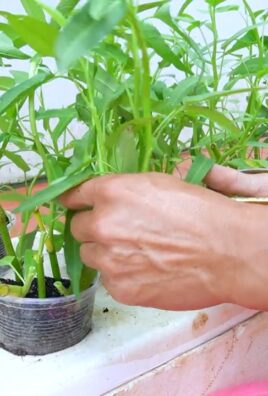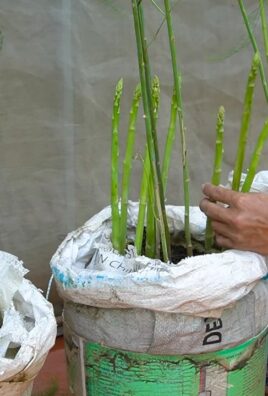Denim Pepper Growing Hack: Ever dreamt of a bountiful pepper harvest bursting with flavor, but feel like your green thumb is more of a beige thumb? Don’t worry, you’re not alone! I’ve been there, staring at sad, stunted pepper plants wondering what I was doing wrong. But what if I told you the secret to pepper-growing success might be hiding in your closet, or more specifically, in your old jeans?
For generations, gardeners have sought innovative ways to boost their yields, from companion planting techniques passed down through families to ancient methods of soil enrichment. While we might not be invoking the spirits of the harvest, we are tapping into the resourceful spirit of DIY! This isn’t just about growing peppers; it’s about embracing a sustainable and creative approach to gardening.
This Denim Pepper Growing Hack is a game-changer because it addresses a common problem: inconsistent soil moisture and temperature. Peppers thrive in warm, consistently moist conditions, and denim, surprisingly, can help achieve just that! By strategically using denim in your pepper beds, you can improve drainage, retain moisture, and even provide a slow-release source of nutrients as the denim breaks down. Plus, it’s a fantastic way to upcycle those old jeans you’ve been meaning to donate (or, let’s be honest, throw away!). So, ditch the gardening gloves for a moment, grab your scissors, and let’s dive into this surprisingly effective and eco-friendly pepper-growing trick!

Denim Planter Power: Grow Peppers in Upcycled Jeans!
Hey there, fellow gardening enthusiasts! Are you looking for a fun, eco-friendly, and totally unique way to grow your peppers this season? Well, look no further! I’m going to show you how to transform your old denim jeans into surprisingly effective and stylish planters. Trust me, it’s easier than you think, and the results are absolutely fantastic. Not only will you be giving your peppers a cozy home, but you’ll also be reducing waste and adding a touch of rustic charm to your garden or balcony. Let’s get started!
What You’ll Need:
Before we dive in, let’s gather our supplies. This is a pretty low-cost project, especially if you already have some of these items lying around.
* **Old Denim Jeans:** The star of the show! Any pair will do, but jeans with a wider leg opening will give your peppers more room to grow. Think bootcut, relaxed fit, or even those trendy wide-leg jeans.
* **Potting Soil:** Choose a high-quality potting mix that’s well-draining. Peppers love soil that’s rich in nutrients.
* **Pepper Seedlings or Seeds:** Decide what kind of peppers you want to grow! Bell peppers, jalapenos, chili peppers – the choice is yours. If you’re starting from seeds, you’ll need to germinate them first.
* **Landscape Fabric or Burlap:** This will line the inside of the jeans and prevent the soil from washing out.
* **Scissors or a Utility Knife:** For cutting the denim and landscape fabric.
* **Staple Gun (Optional):** To secure the landscape fabric to the denim. You can also use fabric glue or even hand-stitch it.
* **Measuring Tape or Ruler:** To measure and cut the landscape fabric.
* **Gloves:** To protect your hands while working with soil.
* **Watering Can or Hose:** For watering your pepper plants.
* **Drainage Material (Gravel, Pebbles, or Broken Pottery):** To ensure proper drainage at the bottom of the planter.
* **Optional Embellishments:** Buttons, paint, patches, twine – get creative and personalize your denim planters!
Preparing Your Denim Planter:
Okay, let’s get our hands dirty! This is where the magic happens.
1. **Choosing Your Jeans:** First things first, select the pair of jeans you want to use. Consider the size of the pepper plants you plan to grow. Larger plants will need more space. Also, think about the overall look you’re going for. Do you want a distressed, vintage vibe, or something more polished?
2. **Cutting the Legs (Optional):** Depending on the length of the jeans and the size of your pepper plants, you might want to cut off the legs. This will make the planter shorter and easier to manage. If you’re using very long jeans, I recommend cutting them off just below the knee. This will give you a good amount of space for the roots to grow.
* Use your scissors or utility knife to carefully cut the legs. Make sure the cut is even.
* If you want a frayed look, you can gently pull at the edges of the denim after cutting.
3. **Creating a Base:** Now, we need to create a base for the planter. This will prevent the soil from falling out of the bottom of the jeans.
* Turn the jeans inside out.
* Fold the bottom of each leg inward, creating a sealed pocket. You’ll essentially be closing off the leg openings.
* Secure the folded denim with staples using a staple gun. If you don’t have a staple gun, you can use fabric glue or hand-stitch the denim together. Make sure the closure is strong and secure.
4. **Lining the Jeans with Landscape Fabric:** This is a crucial step! The landscape fabric will prevent the soil from washing out and keep your planter neat and tidy.
* Measure the inside of the jeans to determine how much landscape fabric you’ll need. You’ll want enough fabric to line the entire inside of the jeans, from the top of the waistband to the bottom of the legs.
* Cut the landscape fabric to the appropriate size.
* Carefully place the landscape fabric inside the jeans, making sure it covers all the denim.
* Secure the landscape fabric to the denim using staples, fabric glue, or hand-stitching. Pay close attention to the top edge of the jeans, making sure the fabric is securely attached.
Planting Your Peppers:
Alright, the planter is ready! Now for the fun part – planting your peppers!
1. **Adding Drainage:** Before adding the soil, it’s important to create a drainage layer at the bottom of the planter. This will prevent the roots from sitting in water and rotting.
* Pour a layer of gravel, pebbles, or broken pottery into the bottom of the jeans. Aim for a layer that’s about 2-3 inches thick.
2. **Filling with Potting Soil:** Now, it’s time to fill the planter with potting soil.
* Slowly pour the potting soil into the jeans, filling them up to just below the top of the waistband.
* Gently pat down the soil to remove any air pockets.
3. **Planting Your Pepper Seedlings:** Carefully remove your pepper seedlings from their containers.
* Dig a small hole in the soil for each seedling.
* Gently place the seedling in the hole, making sure the roots are covered with soil.
* Space the seedlings appropriately, giving them enough room to grow.
* Water the seedlings thoroughly after planting.
4. **Starting from Seeds (Alternative):** If you’re starting from seeds, follow these steps:
* Sow the seeds according to the instructions on the seed packet.
* Keep the soil moist but not soggy.
* Place the planter in a warm, sunny location.
* Once the seedlings have emerged and are large enough to handle, thin them out, leaving only the strongest plants.
Caring for Your Denim Pepper Plants:
Congratulations! You’ve successfully planted your peppers in your upcycled denim planter. Now, it’s important to provide them with the care they need to thrive.
1. **Watering:** Peppers need consistent watering, especially during hot weather. Water deeply whenever the top inch of soil feels dry to the touch. Avoid overwatering, as this can lead to root rot.
2. **Sunlight:** Peppers love sunshine! Place your denim planter in a location that receives at least 6-8 hours of direct sunlight per day.
3. **Fertilizing:** Feed your pepper plants with a balanced fertilizer every 2-3 weeks. This will provide them with the nutrients they need to grow strong and produce lots of peppers.
4. **Support (Optional):** As your pepper plants grow, they may need some support to prevent them from falling over. You can use stakes, cages, or trellises to provide support.
5. **Pest Control:** Keep an eye out for pests, such as aphids, whiteflies, and spider mites. If you notice any pests, treat them with an appropriate insecticide or organic pest control method.
Adding a Personal Touch:
This is where you can really let your creativity shine! Here are some ideas for personalizing your denim planters:
* **Paint:** Use fabric paint to add designs, patterns, or even the names of your peppers to the jeans.
* **Patches:** Sew on patches to give your planters a unique and personalized look.
* **Buttons:** Add buttons to the pockets or waistband for a touch of whimsy.
* **Twine:** Wrap twine around the legs of the jeans for a rustic, farmhouse vibe.
* **Embroidery:** Embroider designs or messages onto the denim.
* **Distressing:** If you want a more rugged look, you can distress the denim by sanding it, tearing it, or adding bleach splatters.
And there you have it! You’ve successfully created a stylish and sustainable denim planter for your peppers. Enjoy watching your plants grow and harvesting your delicious peppers! This project is not only fun and rewarding, but it’s also a great way to reduce waste and add a unique touch to your garden. Happy gardening!

Conclusion
So, there you have it! The Denim Pepper Growing Hack – a simple, sustainable, and surprisingly effective way to boost your pepper plant yields. We’ve explored how this upcycling trick, using discarded denim, can create a more favorable growing environment for your peppers, leading to healthier plants and a more bountiful harvest.
Why is this a must-try? Because it’s more than just a gardening fad. It’s a practical solution that addresses several key challenges pepper plants face. The denim helps regulate soil temperature, preventing overheating in scorching summers and providing a touch of insulation during cooler nights. This consistent temperature is crucial for optimal root development and nutrient absorption. Furthermore, the denim acts as a slow-release watering system, wicking moisture from the surrounding soil and delivering it directly to the roots, reducing water waste and preventing the dreaded overwatering that can lead to root rot. And let’s not forget the added benefit of weed suppression! The denim layer acts as a natural barrier, minimizing weed growth and reducing the need for harmful herbicides.
But the beauty of this hack lies in its adaptability. Feel free to experiment with different types of denim. Thicker denim will provide more insulation and water retention, while thinner denim might be better suited for hotter, drier climates. You can also try layering different types of denim for a customized effect. Consider adding a layer of compost or worm castings beneath the denim for an extra boost of nutrients. For those growing peppers in containers, this hack is especially beneficial, as it helps to maintain consistent moisture levels in the confined space. You can even get creative with the aesthetics! Cut the denim into interesting shapes or patterns to add a touch of personality to your garden.
This isn’t just about growing peppers; it’s about embracing a more sustainable and resourceful approach to gardening. It’s about finding innovative ways to repurpose materials and reduce our environmental impact. It’s about connecting with nature and experiencing the joy of growing our own food.
We wholeheartedly encourage you to give the Denim Pepper Growing Hack a try. It’s a simple, cost-effective, and rewarding way to improve your pepper growing game. Don’t be afraid to experiment and adapt the technique to suit your specific needs and growing conditions.
And most importantly, we want to hear about your experiences! Share your photos, tips, and results with us in the comments below. Let’s create a community of denim-loving pepper growers and learn from each other. Together, we can unlock the full potential of this amazing hack and enjoy a season filled with delicious, homegrown peppers. So, grab your old jeans, get your hands dirty, and let’s get growing! This simple trick can truly transform your pepper patch.
Frequently Asked Questions (FAQ)
What kind of denim works best for this hack?
Any kind of denim can be used, but the thickness of the denim will affect its water retention and insulation properties. Thicker denim, like that found in heavy-duty jeans or jackets, will hold more water and provide better insulation, making it ideal for hotter climates or areas with fluctuating temperatures. Thinner denim, like that found in shirts or lightweight jeans, will dry out more quickly and may be better suited for cooler climates or areas with consistently moist soil. Experiment to see what works best for your specific growing conditions. Consider the color of the denim as well. Darker denim will absorb more heat, which could be beneficial in cooler climates but detrimental in hotter ones. Lighter denim will reflect more heat, making it a better choice for warmer regions.
How do I prepare the denim before using it?
Before using the denim, it’s a good idea to wash it to remove any residual dyes or chemicals that could potentially harm your plants. A simple wash in the washing machine with a mild detergent is sufficient. Avoid using harsh chemicals or bleach, as these could leach into the soil and damage your pepper plants. Once washed, allow the denim to air dry completely before using it in your garden. This will prevent mold or mildew from forming. You can also cut the denim into smaller pieces or strips to make it easier to work with. Consider removing any zippers, buttons, or other hardware that could rust or corrode over time.
How often should I water my pepper plants when using the denim hack?
The denim hack helps to retain moisture in the soil, so you may need to water your pepper plants less frequently than you normally would. The best way to determine when to water is to check the soil moisture level. Stick your finger into the soil about an inch deep. If the soil feels dry to the touch, it’s time to water. If the soil feels moist, you can wait a day or two before watering again. Be careful not to overwater, as this can lead to root rot. The denim will help to distribute the water evenly throughout the soil, so you shouldn’t need to water as deeply as you normally would.
Will the denim attract pests or diseases?
Denim itself is not particularly attractive to pests or diseases. However, if the denim is not properly cleaned or if it remains consistently wet, it could potentially harbor mold or mildew. To prevent this, make sure to wash the denim before using it and allow it to dry completely between waterings. You can also add a layer of mulch on top of the denim to help prevent moisture from accumulating on the surface. Regularly inspect your pepper plants for any signs of pests or diseases and take appropriate action if necessary.
Can I use this hack for other plants besides peppers?
Yes, the Denim Pepper Growing Hack can be used for other plants that benefit from consistent soil moisture and temperature regulation. Tomatoes, eggplants, and other members of the nightshade family are particularly well-suited for this hack. You can also try it with herbs like basil, oregano, and thyme. Just be sure to adjust the watering schedule and other growing conditions to suit the specific needs of the plant. Experiment and see what works best for you! The principles of moisture retention and temperature regulation apply to many different types of plants, so don’t be afraid to get creative.
How long will the denim last before it needs to be replaced?
The lifespan of the denim will depend on several factors, including the quality of the denim, the climate, and the amount of wear and tear it receives. In general, you can expect the denim to last for at least one growing season, and possibly longer. Over time, the denim will naturally break down and decompose, adding organic matter to the soil. When the denim starts to become significantly degraded or if it becomes heavily infested with pests or diseases, it’s time to replace it. You can simply remove the old denim and replace it with fresh denim. The old denim can be composted or used as mulch in other parts of your garden.
Is this hack safe for organic gardening?
Yes, the Denim Pepper Growing Hack is perfectly safe for organic gardening, as long as you use denim that has not been treated with harmful chemicals. As mentioned earlier, it’s a good idea to wash the denim before using it to remove any residual dyes or chemicals. Avoid using denim that has been treated with pesticides or herbicides. If you’re unsure about the origin of the denim, it’s best to err on the side of caution and use organic denim or other natural materials. The denim hack is a sustainable and eco-friendly way to improve your pepper growing game, and it aligns perfectly with the principles of organic gardening.




Leave a Comment